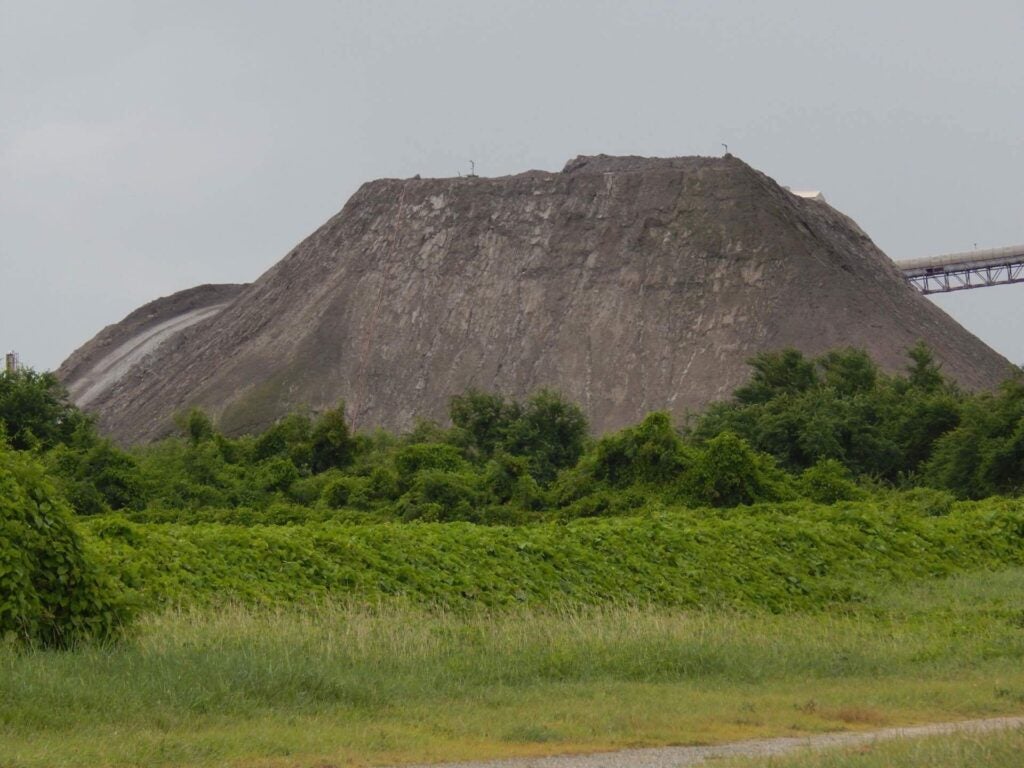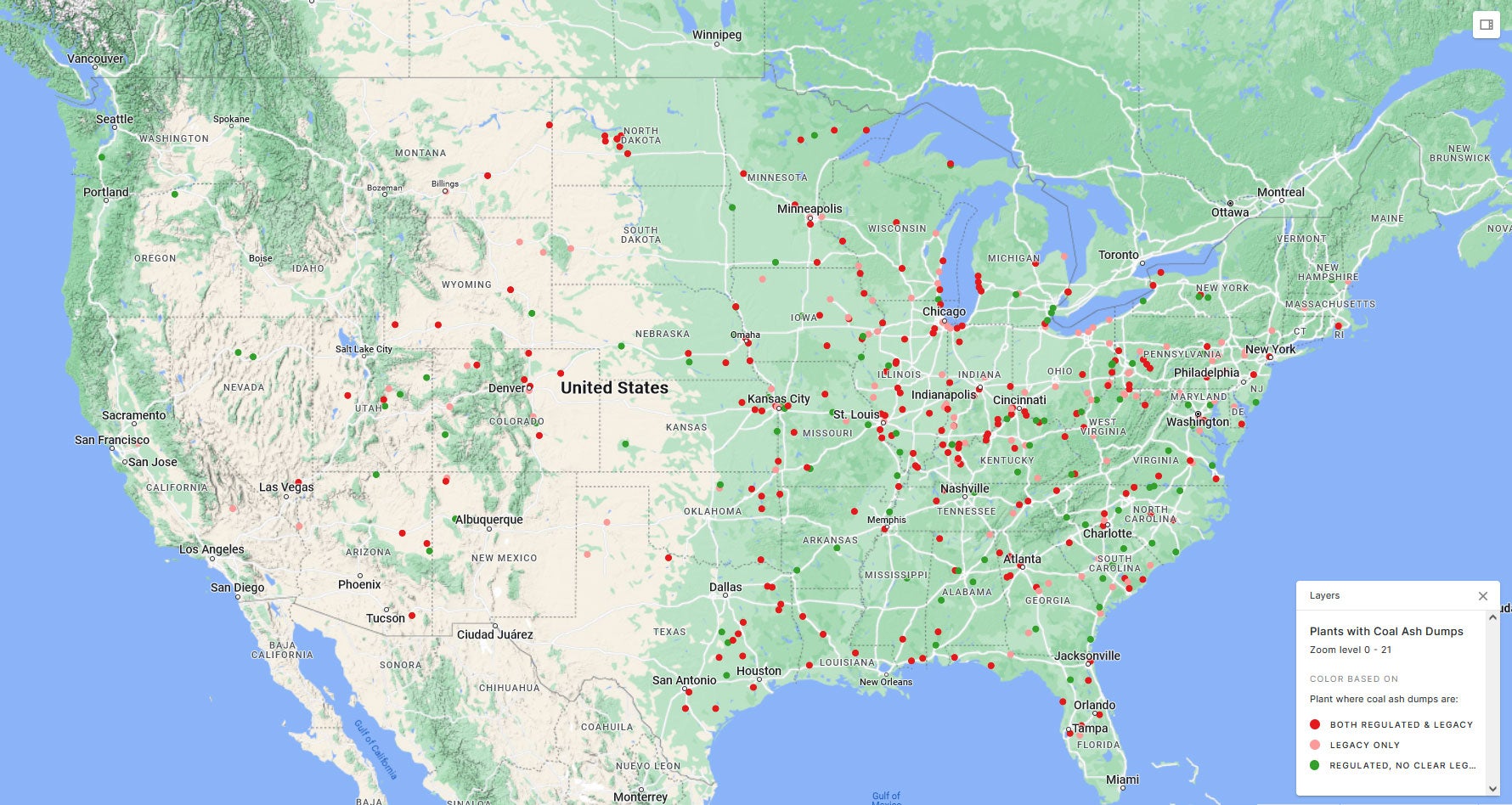May 4, 2023
Toxic Coal Ash in Puerto Rico: The Hazardous Legacy of the AES-PR Coal Plant
Applied Energy Services continues to contaminate the air, soil, and water in Puerto Rico with toxic coal ash.
Since it started burning coal in 2002, the Applied Energy Services — Puerto Rico (AES-PR) coal plant in Guayama, Puerto Rico has failed to contain its coal ash, contaminating the air, soil, and water. AES-PR stored coal ash — the hazardous substance left after burning coal for energy — in a mountainous pile. For years, AES-PR distributed coal ash as cheap fill material, and it was dumped at dozens of sites in southeastern Puerto Rico. The AES-PR coal plant continues to produce an average of 600 tons of coal ash per day.
On this page
Coal ash contains hazardous pollutants including arsenic, boron, cobalt, chromium, lead, lithium, mercury, molybdenum, radium, selenium, and other heavy metals, which have been linked to cancer, heart and thyroid disease, reproductive failure, and neurological harm. In 2023, the EPA acknowledged that coal ash is even more dangerous than previously thought, with levels of arsenic and radiation that pose cancer risks.
Despite EPA’s 2015 Coal Ash Rule, which created the first-ever safeguards for coal ash disposal, many coal ash dumps remained unregulated due to sweeping exemptions for legacy coal ash ponds and inactive landfills.
The exempted coal ash dumps are sited disproportionately in low-income communities and communities of color.
After years of litigation and grassroots activism, the EPA extended clean up requirements to hundreds of old coal ash dumps across the country when it issued new regulations in the spring of 2024. But the revised rule does not address coal ash that was dumped off-site or used as fill, which occurred at dozens of locations in Puerto Rico.

Action Needed
The magnitude of harm from recklessly dumped toxic coal ash requires decisive action from federal and state regulators.
- AES-PR must be required to comply with the law and immediately clean up its pollution.
- EPA and territorial authorities must act quickly to make enforcement a priority and act quickly to ensure that AES-PR’s ash throughout Puerto Rico does not cause any more harm.
- EPA must take action to prohibit the use of coal ash as construction fill and make polluters clean up areas where ash was used as fill.
The longer enforcement is delayed, the more hazardous contaminants enter Puerto Rico’s air and water and the more difficult cleanup will be. EPA must force AES to clean up and contain coal ash at its plant. But the EPA must also prohibit the use of coal ash as fill and make AES clean up areas where ash was scattered around southeastern Puerto Rico.
Harm to Groundwater from the AES-PR Coal Plant
Puerto Rico’s one coal-burning power plant is located on the southeast coast of the archipelago. AES, a multinational corporation with assets exceeding $33 billion, opened its Guayama plant in 2002. Since the plant’s opening, AES-PR has failed to protect Puerto Ricans from the plant’s toxic waste. AES-PR leaves its enormous coal ash pile uncovered, which has allowed the ash to blow into homes and nearby schools and leaves it vulnerable to hurricane-force winds and rain. The AES-PR coal ash pile is sited above the South Coast Aquifer that serves as the source of drinking water for tens of thousands of people in southern Puerto Rico. Groundwater monitoring data published by AES-PR reveals levels of boron, lithium, molybdenum, selenium, and sulfate above federal health standards.[i]
Toxic Fugitive Dust from the AES-PR Coal Plant
Fugitive dust emissions from the waste pile have caused harm to the health of nearby residents. For over a decade, the waste pile dwarfed all other structures at the plant and still stands with no cover, totally exposed to the persistent Caribbean winds and tropical rainstorms.
Fugitive dust emissions can have grave consequences for the local community. In July 2016, the University of Puerto Rico, Graduate School of Public Health conducted an epidemiological study of communities downwind from the AES-PR plant. The study concluded that the Guayama community suffers higher incidence of respiratory disease, cardiovascular disease, asthma, hives, spontaneous abortions, bronchitis than a community whose air and environment are not impacted by the power plant.[ii]
AES-PR Is Not Cleaning Up Contaminated Groundwater as Mandated by the Federal Coal Ash Rule
Despite the legal requirement to do so, AES-PR has failed to implement a corrective action remedy that would adequately clean up the groundwater contamination at the Guayama plant and prevent further contamination. AES-PR’s plan consists of installing a synthetic liner under the waste pile in dangerous proximity to the water table and employing a “do nothing” approach known as Monitored Natural Attenuation (MNA) to watch rather than clean up the existing groundwater contamination. In January 2022, EPA issued a letter to AES-PR identifying deficiencies in the company’s cleanup plan and reiterating the EPA’s position that MNA is not an appropriate remedy.
In June 2022, EPA Region 2 issued a Notice of Potential Violations identifying several violations of the Coal Ash Rule’s groundwater monitoring and reporting requirements. Specifically, AES-PR failed to provide groundwater data from certain samples taken over the past five years that are critical to determining the full nature and extent of contamination from the waste pile.
AES-PR’s Violation of Clean Air Act Requirements
AES-PR repeatedly violated federal clean air standards. On July 25, 2022, EPA Region 2 issued a notice of violation under the Clean Air Act, finding that the Guayama plant exceeded emission limits for pollutants such as nitrogen dioxide, carbon monoxide, sulfur dioxide, and mercury. According to the notice, AES-PR also violated the Puerto Rico Regulations for the Control of Atmospheric Pollution by exceeding the visible emissions and opacity limitations 86 times in 2021. The notice also identified several violations of the Clean Air Act’s Mercury and Air Toxics Standards. AES-PR also violated the reporting provisions of the plant’s Prevention of Significant Deterioration permit by failing to submit quarterly reports of all excess emissions to EPA for 2017 through 2021.
Coal Ash Contamination in Puerto Rico from “Fill” Projects
From approximately 2004 to 2012, AES-PR distributed more than 2 million tons of coal ash as cheap fill material to dozens of sites in Puerto Rico, including housing, commercial developments, and road projects.[iii] The coal ash, called “Agremax” by AES-PR, is comprised of fly ash and bottom ash mixed with water. In 2012, Vanderbilt University completed a study on the leaching potential of Agremax for EPA, Region 2 and concluded that Agremax leaches particularly high concentrations of arsenic, boron, chloride, chromium, fluoride, lithium, and molybdenum.[iv]
The EPA recently acknowledged that coal ash is even more dangerous than previously thought, with levels of arsenic and radiation that pose cancer risks. People may be exposed to dangerous levels of radiation from coal ash used as fill.
AES-PR’s coal ash was often used to grade sites in flood-prone areas. In some cases, ash was placed in excess quantities and in areas clearly not safe for coal ash disposal.[v] The majority of sites are directly above the South Coast Aquifer and close to public supply water wells, wetlands, or the Jobos Bay National Estuarine Research Reserve. Puerto Rico’s rainy, hurricane-prone climate is incompatible with the use of coal ash for structural fill. The archipelago’s reliance on groundwater for drinking water increases the risk of human exposure to coal ash pollutants.
At numerous sites, the toxic ash still lies unused and uncovered on the ground, and these piles pose dangers in residential areas, near parks, a school and even a hospital. Fugitive dust from these uncovered piles and roads is common.
Environmental Justice and Coal Ash in Puerto Rico
The Guayama region, where many residents are Afro-Puerto Rican, has a high rate of poverty. According to the Toxic Release Inventory, this region suffers the greatest contamination of any region in Puerto Rico. The region also has among the highest unemployment and school dropout rates on the archipelago. The region experienced a sharp decrease in medical services with only one hospital currently in operation. AES-PR’s waste pile, offsite disposal of coal ash in the region, and continued reckless operation of the plant impose disproportionate public health risks to this environmental justice community.
Regulated and Unregulated Coal Ash Disposal Sites in Puerto Rico
The AES-PR waste pile is the only coal ash disposal site in Puerto Rico that is regulated by the 2015 Coal Ash Rule.
The coal ash waste pile is contaminating groundwater at unsafe levels.
In addition, there are approximately 30 unregulated coal ash fill sites, consisting of both covered and uncovered ash deposits, throughout southeastern Puerto Rico.
Because AES-PR was not required to report the location of ash placement, the number of dumpsites that escape federal regulation remains unknown. While these unregulated sites are almost certainly contaminating water and threatening health and the environment, monitoring data are not available.
| AES-PR Guayama Plant (520 MW) | Guayama | AES-PR | Coal ash waste pile (121,213 tons in 2021) | Boron (x2), Lithium (x18), Molybdenum (x12), Selenium (x4), Sulfate (x7) |
"Coal Ash Dumps": CCR 2021 Inspection Report: AES Puerto Rico
All data on groundwater contamination from coal ash derived from the utilities’ publicly accessible CCR Compliance Data and Information websites, and exceedances were calculated by Environmental Integrity Project.
For More Information
Christine Santillana, Senior Legislative Counsel, Earthjustice, csantillana@earthjustice.org
Lisa Evans, Senior Counsel, Earthjustice, levans@earthjustice.org.
More on Coal Ash in Puerto Rico
- Poisonous Coverup: The Widespread Failure of the Power Industry to Clean Up Coal Ash Dumps (November 3, 2022)
- AES Puerto Rico: 20 years of coal ash contamination (January 13, 2022)
- Tr-Ash Talk: Puerto Rico Communities Seek Justice, Protection (September 27, 2012)
- Tr-Ash Talk: Dumping On The Americas (May 25, 2011)
- Teen Who Grew up Beside a Coal Ash Pile Would Like a Word With the EPA (April 27, 2018)
Coal Ash in States, Territories, Regions
Puerto Rico (En Español)
Earthjustice fights in the courts for a long-term solution to the toxic menace of coal ash. And we act on behalf of dozens of clients and over 100 coalition partners to defeat legislative attempts to subvert federally enforceable safeguards of coal ash.
Earthjustice’s Clean Energy Program uses the power of the law and the strength of partnership to accelerate the transition to 100% clean energy.
